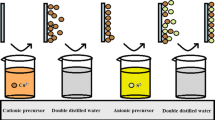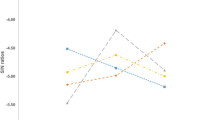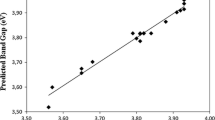Abstract
This paper presents the optimal configuration of parameters for the elaborated Cu2ZnSnS4 (CZTS) absorber layer, using the sol–gel method associated with dip-coating technique on ordinary glass substrates. Taguchi design of experiments with L27 (38) orthogonal array, a signal-to-noise (S/N) ratio, and an analysis of variance (ANOVA) were used to determine the best optical properties for photovoltaic applications (optical bandgap energy) of CZTS thin films. Eight factors named annealing temperature, Cu/(Zn+Sn) ratio, Zn/Sn ratio, S/metal ratio, number of pre-annealing and dip coating, dip-coating cycle, annealing time, and dip-coating speed were chosen. To conduct the tests, we apply Taguchi method; three levels were fixed for each factor. The most important factors of the deposition approach on the optical properties of the fixed as-synthesized CZTS films were determined. The analysis of the obtained results indicated that the important parameters are the Zn/Sn ratio and annealing temperature in air by employing Taguchi approach. A validation test is also carried out to check whether the found optimal combinations of the parameter are correct. CZTS thin-film synthesis with optimal conditions has been characterized, using an X-ray diffractometer (XRD), energy-dispersive X-ray spectroscopy (EDS), scanning electron microscopy (SEM), UV–visible spectrophotometer, and four-point probe method. XRD data show a kesterite structure with a preferential orientation along the (112) plan; UV–visible spectrophotometer indicated that the bandgap energy of the CZTS thin film is 1.51 eV and a cross section showed the suitable film thickness in the order of ~1.80 µm.

Highlights
-
Synthesis of CZTS thin films by sol gel associated to the dip-coating technique.
-
Application of Taguchi method to optimize the sol gel dip-coating process of the semiconductor CZTS with good optical properties.
-
The statistical analysis (ANOVA) has the capacity to give information about certain statistical parameters.
-
The CZTS thin film elaborated with optimal parameters has good morphological optical and electrical properties.








Similar content being viewed by others
References
Green MA, Emery K, Hishikawa Y, Warta W, Dunlop ED (2015) Solar cell efficiency tables (version 46). Prog Photovolt Res 23:805–812
Thota N, Gurubhaskar M, Kasi Reddy AC, Chandra GH, Mehta BR, Tiwari A, Subbaiah YPV (2017) Growth and properties of Cu2ZnSnS4 thin films prepared by multiple metallic layer stacks as a function of sulfurization time. J Mater Sci Mater Electron 28(16):11702–11711
Guo BL, Chen YH, Liu XJ, Liu WC, AD Li (2014) Optical and electrical properties study of sol–gel derived Cu2ZnSnS4 thin films for solar cells. AIP Adv 4(9):1–10
Patel SB, Gohel JV (2017) Effect of type of solvent on the sol–gel spin coated CZTS thin films. Phys Astronom Int J 1(4):1–5
Chen S, Gong XG, Walsh A, Wei Su-Huai (2009) Crystal and electronic band structure of Cu2ZnSnX4 (X=S and Se) photovoltaic absorbers: first-principles insights. Appl Phys Lett 94:041903
Agawane GL, Kamble AS, Vanalakar SA, Shin SW, Gang MG, HoYun Jae, Gwak Jihye, Moholkar AV, Kim JH (2015) Fabrication of 3.01% power conversion efficient high-quality CZTS thin film solar cells by a green and simple sol–gel technique. Mater Lett 158:58–61
Pawar SM, Pawar Bharati S, Gurav KV, Bae DW, Kwon SH, Kolekar SS, Kim JH (2012) Fabrication of Cu2ZnSnS4 thin film solar cell using single step electrodeposition method. J Appl Phys 51:1–4
Zhuk S, Kushwaha A, Wong TKS, M-Panah S, Smirnov A, Kumar Dalapati G (2017) Critical review on sputter-deposited Cu2ZnSnS4 (CZTS) based thin film photovoltaic technology focusing on device architecture and absorber quality on the solar cells performance. Sol Energy Mater Sol Cell 171:239–252
Tanaka T, Kawasaki D, Nishio M, Guo Q, Ogawa H (2006) Fabrication of Cu2ZnSnS4 thin films by coevaporation. Physica Status Solidi 3(8):2844–2847
Arba Y, Rafi M, Hartiti B, Ridah A, Thevenin P (2011) Preparation and properties of CZTS thin film prepared by spray pyrolysis. Moroc J Condens Matter 13(3):100–103
Rana TR, Shinde NM, Ho Kim J (2016) Novel chemical route for chemical bath deposition of Cu2ZnSnS4 (CZTS) thin films with stacked precursor thin films. Mater Lett 162:40–43.
Moholkar AV, Shinde SS, Babar AR, Sim Kyu-Ung, Kwon Ye-bin, Rajpure KY, Patil PS, Bhosale CH, Kim JH (2011) Development of CZTS thin films solar cells by pulsed laser deposition: influence of pulse repetition rate. Sol Energy 85:1354–1363
Araki H, Mikaduki A, Kubo Y, Sato T, Jimbo K, Shwe Maw W, Katagiri H, Yamazaki M, Oishi K, Takeuchi A (2008) Preparation of Cu2ZnSnS4 thin films by sulfurization of stacked metallic layers. Thin Solid Film 517:1457–1460
Mali SS, Shinde PS, Betty CA, Bhosale PN, Woo Oh Y, Patil PS (2012) Synthesis and characterization of Cu2ZnSnS4 thin films by SILAR method. J Phys Chem Solid 73:735–740
Seo D, Kim C, Oh E, Hong CW, Kim JH, Lim S (2014) Control of metal salt ratio and MoS2 layer thickness in a Cu2ZnSnS4 thin film solar cell. J Mater Sci: Mater Electron 25(8):3420–3426
Aslan F, Göktaş A, Tumbul A (2016) Influence of pH on structural,optical, and electrical properties of solution processed Cu2ZnSnS4 thin film absorbers. Mater Sci Semicond Process 43:139–143
Prabeesh P, Saritha P, Packia Selvam I, Potty SN (2017) Fabrication of CZTS thin films by dip- coating technique for solar cell applications. Mater Res Bull 86:295–301
Kumar Chaudhuri T, Tiwari D (2012) Earth-abundantnon-toxic Cu2ZnSnS4 thin films by direct liquid coating from metal–thiourea precursor solution. Sol Energy Mater Sol Cell 101:46–50
Truong Mau T, Kim Ho (2012) Synthesis of Cu2ZnSnS4 thin film absorbers by sulfurizing dip-coated precursors. J Ceram Process Res. 13(3):301–304
Wang W, Winkler MT, Gunawan O, Gokmen T, Todorov TK, Zhu Y, Mitzi DB (2014) Device characteristics of CZTSSe thin film solar cells with 12.6% efficiency. Adv Energy Mater 4:1–5
Katagiri H, Jimbo K, Tahara M, Araki H, Oishi K (2009) The influence of the composition ratio on CZTS-based thin film solar cells. J Mater Res Soc Symp Proc 1165:1–12
Arba Y, Tchognia JH Nkuissi, Hartiti B, Ridah A,Thevenin P (2014) Determination of the optimal conditions for the deposition of Cu2ZnSnS4 (CZTS) thin films by spray pyrolysis using Taguchi method, 2014 International renewable and sustainable energy conference (IRSEC). Ouarzazate, p 705–710
Ammaih Y, Lfakir A, Hartiti B, Ridah A, Siadat M, Thevenin P (2016) Optimization of parameters for deposition of ZnO films by sol–gel using Taguchi method. Mol Cryst Liq Cryst 13:176–182
Elfarrass S, Hartiti B, Ridah A, Thevenin P (2016) Optimization of parameters for deposition of In2S3 films by spray pyrolysis using Taguchi method. Cryst Liq Cryst 628(1):139–144
khalidi El Z, Hartiti B, Fadili S, Thevenin P (2018) Nickel oxide optimization using Taguchi design for hydrogen detection. Int J Hydrog Energy 43(27):12574–12583
Athreya S, Venkatesh YD (2012) Application of Taguchi method for optimization of process parameters in improving the surface roughness of lathe facing operation. IRJES 1(3):13–19
Sukthomya W (2005) Taguchi experimental design for manufacturing process optimisation using historical data and a neural network process model. Int J Qual Reliab Manag 22(5):485–502
Yang WH, Tamg YS, Mater J (1998) Design optimization of cutting parameters for turning operations based on the Taguchi method. J Mater Process Technol 84:122–129
Chiang YM, Hsieh H-H (2009) The use of the Taguchi method with grey relational analysis to optimize the thin-film sputtering process with multiple quality characteristic in color filter manufacturing. Comput Ind Eng 56:648–661
Chen L-J, Chuang Y-J (2013) Quaternary semiconductor derived and formation mechanism by nonvacuum route from solvothermal nanostructures for high-performance application. Mater Lett 91:372–375
Swami SK, Kumar A, Dutta V (2013) Deposition of kesterite Cu2ZnSnS4 (CZTS) thin films by spin coating technique for solar cell application. Energy Procedia 33:198–202
Chiang YM, Hsieh H-H (2009) The use of the Taguchi method with gray relational analysis to optimize the thin-film sputtering process with multiple quality characteristic in color filter manufacturing. Comput Ind Eng 56:648–661
Tong L-I, Su C-T (1997) Optimizing multi-response problems in the Taguchi method by fuzzy multiple attribute decision making. Qual Reliab Int 13:25e34
Song X, Xu Ji, Li M, Lin W, Luo X, Zhang H (2014) A review on development prospect of CZTS based thin film solar cells. Int J Photoenergy Vol. 2014
Ansari MZ, Khare N (2014) Structural and optical properties of CZTS thin films deposited by ultrasonically assisted chemical vapour deposition. J Phys D Appl Phys 47(18):185101
Seboui Z, Gassoumi A, Cuminal Y, Kamoun-Turki N (2014) Effect of annealing process on the properties of Cu2ZnSnS4 thin films. Superlattices Microstruct 75:586–592
Feng W, Han J, Ge J, Peng X, Liu Y, Jian Y, Yuan L, Xiong X, Cha L, Liao C (2017) Influence of annealing temperature on CZTS thin film surface properties. J Electron Mater 46(1):288–295
Tchognia JHN, Hartiti B, Ridah A, Ndjaka J-M, Thevenin P (2016) Application of Taguchi approach to optimize the sol–gel process of the quaternary Cu2ZnSnS4 with good optical properties. Opt Mater 57:85–92
Patel SB, Gohel JV (2018) Optimization of sol–gel spin-coated Cu2ZnSnS4 (CZTS) thin-film control parameters by RSM method to enhance the solar cell performance. J Mater Sci Electron Mater 53:12203–12213
Hsu S-F, Chou J-H, Fang C-H, Weng M-H (2014) Optimization of the Cathode Arc Plasma Deposition Processing Parameters of ZnO Film Using the Grey-Relational Taguchi Method. Hindawi Publishing Corporation Advances in Materials Science and Engineering Vol 2014, Article ID 187416
Pan LK et al. (2005) Optimization of Nd:YAG laser welding onto magnesium alloy via Taguchi analysis. Opt Laser Technol 37(1):33–42
Kaladhar M et al. (2011) Application of Taguchi approach and utility concept in solving the multi objective problem when turning AISI 202 austenitic stainless steel. J Eng Sc Technol Rev 4(1):55–61
Mohan S, Sivapirakasam S, Santhosh Kumar MC, Surianarayanan M (2011) Application of Taguchi method in the optimization of process parameters for a sol–gel-derived nano-alumina film. J Eng Sci Technol Rev 4(1):55–56
Tarng YS et al. (2002) The use of grey-based Taguchi methods to determine submerged arcwelding process parameters in hardfacing. J Mater Process Technol 128(1–3):1–6
Ghani JA, Choudhury IA, Hassan HH (2004) Application of Taguchi method in the optimization of end milling parameters. J Mater Process Technol 145:84–92
Kumari N, Gohel JV, Patel SR (2017) Multi-response optimization of ZnO thin films using Grey-Taguchi technique and development of a model using. ANN Optik 144:422–435
Dasgupta K, Sen D, Mazumder S, Basak CB, Joshi JB, Banerjee S (2010) Optimization of parameters by Taguchi method for controlling purity of carbon nanotubes in chemical vapour deposition technique. J Nanosci Nanotechnol 10:4030–4037
Ren Y, Scragg J, Frisk C, Larsen JS, Li S-Y, Platzer-Bjorkman C (2015) Influence of the Cu2ZnSnS4 absorber thickness on thin film solar cells. Phys Status Solidi A 212(12):2889–2896
Seboui Z, Cuminal Y, Kamoun-Turki N (2013) Physical properties of Cu2ZnSnS4 thin films deposited by spray pyrolysis technique. J Renew Sustain Energy 5:023113
Diwate K, Mohite K, Shinde M, Rondiya S, Pawbake A, Date A, Pathan H, Jadkar S (2017) Synthesis, and characterization of chemical spray pyrolysed CZTS thin films for solar cell applications. Energy Procedia 110:180–187
Thota N, Gurubhaskar M, Reddy Kasi AC, Chandra Hema G, Mehta BR, Tiwari A, Subbaiah Venkata YP (2017) Growth and properties of Cu2ZnSnS4 thin films prepared by multiple metallic layer stacks as a function of sulfurization time. J Mater Sci Mater Electron 28:11702–11711
Aldalbahi A, Mkawi EM, Ibrahim K, Farrukh MA (2016) Effect of sulfurization time on the properties of copper zinc tin sulphide thin films grown by electrochemical deposition. Sci Rep 6:32431
Chavda A, Patel M, Mukhopadhyay I, Ray A (2016) Facile, noncyanide based etching of spray deposited Cu2ZnSnS4 thin films for secondary phase removal. ACS Sustain Chem Eng 4(4):2302–2308
Tauc J, Grigorivic R, Vancu A (1996) Optical properties and electronic structure of amorphous germanium. Phys Stat Sol 15:627
Zdanowicz T, Rodziewicz T, Zabkowska-Waclawek M (2005) Theoretical analysis of the optimum energy band gap of semiconductors for fabrication of solar cells for applications in higher latitudes locations. Sol Energy Mater Sol Cells 87:757–769
Jiang M, Li Y, Dhakal Rabin, Thapaliya P, Mastro M, Caldwell JD, Kub F, Yan X (2011) Cu2ZnSnS4 polycrystalline thin films with large densely packed grains prepared by sol–gel method. J Photon Energy 1(1):019501
Acknowledgements
Prof. Bouchaib HARTITI, senior associate at ICTP (The Abdus Salam International Centre for Theoretical Physics), is very grateful to ICTP for financial support. Technical support from LMOPS (University of Lorraine, France) is also acknowledged.
Author information
Authors and Affiliations
Corresponding author
Ethics declarations
Conflict of interest
The authors declare that they have no conflict of interest.
Additional information
Publisher’s note: Springer Nature remains neutral with regard to jurisdictional claims in published maps and institutional affiliations.
Rights and permissions
About this article
Cite this article
Ziti, A., Hartiti, B., Labrim, H. et al. Application of Taguchi method to optimize the sol–gel dip-coating process of the semiconductor Cu2ZnSnS4 with good optical properties. J Sol-Gel Sci Technol 91, 364–373 (2019). https://doi.org/10.1007/s10971-019-05040-0
Received:
Accepted:
Published:
Issue Date:
DOI: https://doi.org/10.1007/s10971-019-05040-0




